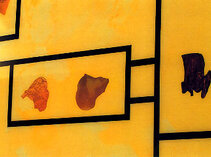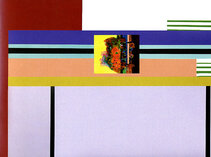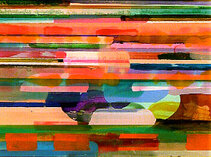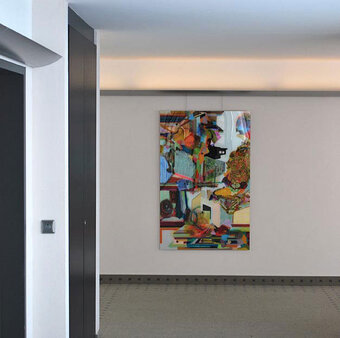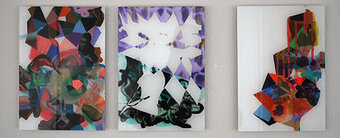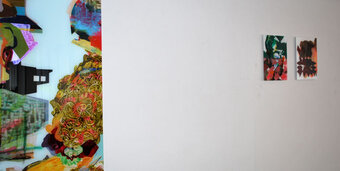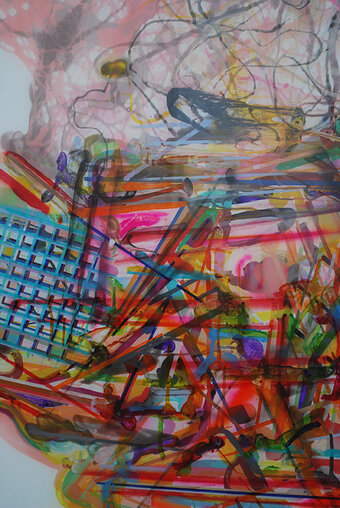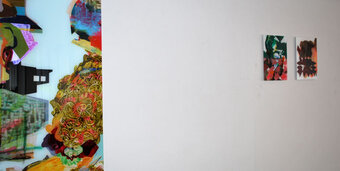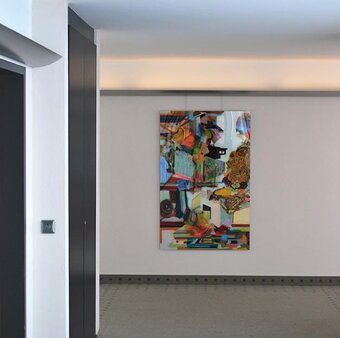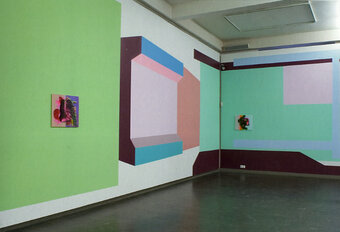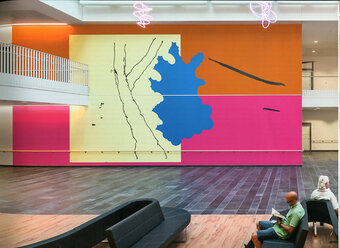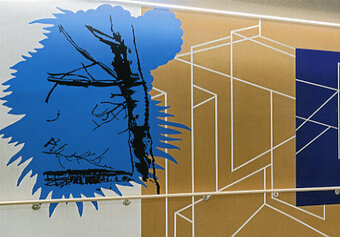Michael Jäger
May 16, 2010What is a Gesamtkunstwerk? A synthesis of all the arts? That would be too little and too vague, at least for Michael Jäger. One should rather think of connections and references that can be experienced through the aesthetic. People in space do not think of the three dimensions that enable them to experience space, but define themselves through their senses: they see colored walls and can feel them, they hear sounds and can see them.
The whole is more than the sum of its parts. Jäger demonstrates this statement by installing a "boundless" series of pictures in the Salon Ornet (Wilhelm-Hack-Museum, Ludwigshafen 2006), for example, which come together to form a homogeneous spatial experience. If you try to isolate a single picture, the space is lost.
Perhaps this idea already emerged in 1991, when he installed the exhibition "Summe+Rest" at the Düsseldorf Kunstverein für die Rheinlande und Westfalen. In order not to remain a "remainder", the visitor had to enter into the artistic ambience, no, even more: into the picture itself.
Jäger provokes "immersion in the picture". You want to read between the lines to find out more about himself, about his imaginative ability and about his sensitivity to form and color.
View through the corridor to Ornet, 2008
Jäger's works date from the last few years (2007-2010). The immediate presence of color and form is also due to the technique: Acrylic glass, lacquer, oil
From the Nice Guys series, 2009/2010
You'd like to see them as Nice Guys, handsome fellows, the abstract figures in their festive clothes and on their way to the Jäger color festival.
We delve into the details of Ornet 2007/2008 and take a closer look at the material from which the pictures are created. Ornament has always been a source of ideas for motifs and pictorial genres: Vine decorations in medieval codices became independent still lifes and rococo decoration grew into idyllic pastoral pieces.
Jäger's arsenal of forms is diverse and multi-layered. It sets the artistic pace for the rhythmic dance of the groups of figures - sometimes ornate and playful, sometimes strictly arranged and orderly.
Vita
- Born in Düsseldorf in 1956.
- Scholarships from the Villa Romana/Florence (1987), the Cité International des Arts/Paris (1997) and the Rainer Bartels Foundation/Basel (2005/06), among others.
- 1993-1994 lecturer in painting at the Fachhochschule für Gestaltung in Pforzheim.
- 1995-1996 visiting professor at the Justus Liebig University in Giessen.
- 1999 moved to the Royal Danish Academy in Odense (Denmark) as artist in residence.
- Lives and works in Cologne.
Exhibitions in recent years (selection)
2006:
- Zwischenraum, Kunsthalle Recklinghausen (with Krimhild Becker)
- Salon Ornet, Wihelm-Hack-Museum Ludwigshafen n Bloom and Ornet, Galerie Frank Schlag&Cie, Essen
- Malabar Chartreuse, Galerie Katharina Krohn, Basel with Ben Hübsch
2007:
- IF Gallery Erhard Witzel, Wiesbaden
- The Second, Melchior Art Agency, Kassel with Dorothee Rocke
- PinkPink, Angus Broadbent Gallery, London
2008:
- Händisch, Gallery Schneider/Bonn
Architectural concepts
A painting by Michael Jäger - framed and hung on the wall - seems disconcerting at first glance, because we are confronted with a conglomerate of brightly colored forms in seemingly incoherent structures. After looking at it for a while, one is tempted to reshape the picture, by which I do not mean the subject of the picture but the surroundings, the open spaces beyond the picture frame. This refers to the wall, the room and the architecture. One could now take action and draw the painting over the entire wall surface, up to the ceiling and down to the baseboard. This is followed by an open wall surface and then another architectural painting ...
We can probably only undertake such a deconstruction and new construction in our minds because we are largely familiar with the artist's work.
Ornet # 15, 2002
The combination of Ornet # 15, 2002 with the Nice Guys from 2009/2010 in the University Heart Center Freiburg ∙ Bad Krozingen is intended to present such a wall. For Michael Jäger, these are architectural concepts.
The picture sequence 6 Souvenirs (1996-2004, Station 5 of the University Heart Center) could also lend dynamism and charm to the architecture as a pictorial wall structure.
It is probably not the case that the artist uses architecture as a medium to fill empty wall surfaces and make them colorful. Nor should his works be labeled as constructed architectural paintings. Rather, architecture and painting are an intimate brother and sister. When the artist stands in front of a wall, he probably asks it if he can paint a picture on it. The architecture answers: You can, because you are Michael Jäger.
Such a dialog has taken place in the Kunsthalle Recklinghausen. In the intermediate space photographed from this perspective, the middle part of the picture with the console and plinth moves from the second to the third dimension. This effect is due to the color contrast and the form. If you move your point of view in the other direction, the corner of the room dissolves for the same reasons and recedes into the second dimension. The architecture can be proud of its sister.
Now in this case it is an illusionistic gimmick. Why not? It's fun and proves that painting not only decorates architecture, but also helps to shape it. This is probably also Michael Jäger's aim, to plan a building in dialog with the architects. It is a give and take: The wall surface that the artist receives from the architect and the artistic structure that the architect accepts from the artist.
The dialog between architecture and painting should not be understood as art on the building, but rather as art with the building. This must have been what the management of Schwarzwald-Baar-Klinikum Villingen-Schwenningen GmbH had in mind when they called for the unity of architectural design and visual art for the new building of their clinic in 2011. A committee of experts made the necessary preparations and a jury was formed. They opted for the Quartett project presented by Michael Jäger, which was intended for the foyer and the main corridor, a 250-metre-long corridor that provides access to the various hospital areas.
The total length of the main corridor (north and south sides, 2 levels each) is 1,000 meters. Jäger developed the pictorial concept together with the artists David Harley, Jürgen Palmtag and Volker Saul. The wall surfaces were designed in time for the inauguration of the clinic on July 6, 2013.
Jürgen Palmtag's drawn paintings, his meticulously applied signs, rummage through the viewer's iconic arsenal of memories and can probably only be deciphered through moods or atmospheric sounds that suddenly arise.
In contrast, David Harley's sfumato-like spray pieces invite us to touch or grasp them, as if we can not only see but also feel the sounds of color.
Volker Saul's monochrome structures, decidedly planar and suggesting rods or bubbles, have established themselves as veritable puzzle forms.
On the first floor of the Magistrale. Incidentally, the artists had a postcard made with this picture. It bears the title: WE SURVIVED THE MAGISTRALE.
Michael Jäger's contributions focus on color fields that structure the walls in quasi-spatial dimensions, opening them up and thus setting them in apparent motion. He then creates a contrast in the form of soft and irregular areas of color that are traversed by long black canyons and channels. These are interventions in the well-ordered lines, similar to the way an illness disrupts the usual and familiar structures of life.

View through doors to the main hall on the upper floor

Part of the Magistrale on the first floor


